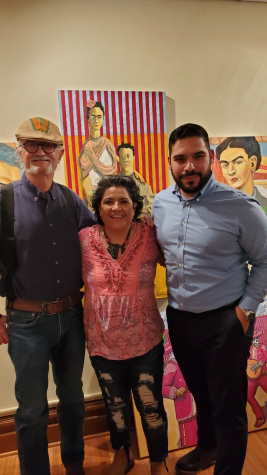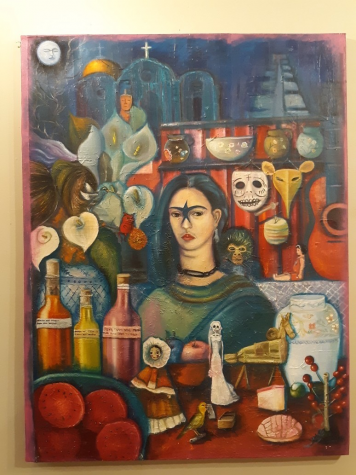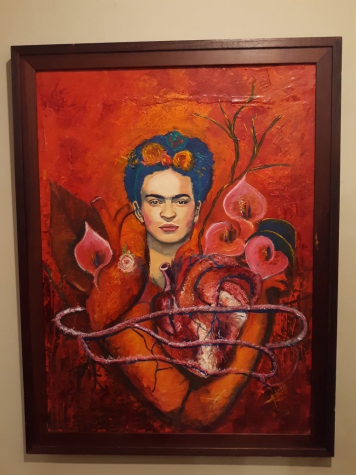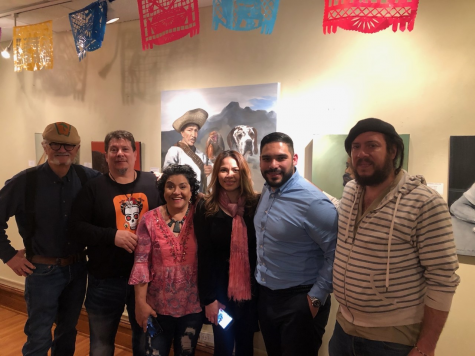What would Frida do? (Don’t misunderstand her political message)
Artist and Mexican folklorist Jade Nava demonstrates establishing Mexican identity through ancestral folk stories. Artists gathered at the Burning Bush art gallery in Wheaton, in an event hosted by Immigrant Solidarity DuPage, to discuss the influences of Frida Kahlo on their art and the enduring relevance of her revolutionary political spirit (photo by Gabriela Hernandez Chico)
November 29, 2019
“I’m convinced of my disagreement with the counterrevolution, imperialism, fascism, religions, stupidity, capitalism and the whole gamut of bourgeois tricks. I wish to cooperate with the Revolution in transforming the world into a classless one so we can attain a better rhythm for the oppressed classes.” – Frida Kahlo (1907-1954)
Attempting to capitalize off ‘Fridamania,’ the College of DuPage is spending $3 million on construction and security to exhibit 19 Frida Kahlo paintings in Summer 2020. Profiting off her popularity, society has corporatized her unibrowed face onto t-shirts, coffee mugs, posters and anything else that can be marketed to the masses. Her “Two Nudes in the Forest” (1939) painting sold for $8 million at a 2016 Christie’s auction.
As society iconizes a figure, they commoditize the person to represent simplified caricatures devoid of the artist’s true spirit and complexities. Frida was a devout communist who championed the rights of Mexican workers and the indigenous by calling for the destruction of the social and political elite. She was also openly bisexual. Frida has been made a hero by feminists, Latinos, socialists and the LGBTQ community.
The irony of the COD Board of Trustee’s decision to host Frida’s radical works cannot be lost on the spectator. The board was recently involved in a pay dispute with the teaching faculty union in what some deemed a political stunt to embellish their Republican credentials in being anti-labor union. The board also recently involved the openly anti-LGBTQ and anti-immigrant former State Rep. Jeanne Ives (R) in a presidential search committee to the dismay of many faculty and students. Many of the college’s top donors represent the evangelical religious voting bloc. However, come June, the school will host paintings from an artist who dedicated her life to have peoples’, like the elite board member’s, worlds torn down.
Will students misunderstand the true meaning of Frida’s works?
(Joey Weslo: COD Board invites Jeanne Ives’ discrimination)

Considering the polarized political climate and hostilities towards the Latino community, non-profit Immigrant Solidarity DuPage hosted an artist reception Nov. 22 at the Burning Bush art gallery in Wheaton for the exhibit, “What Would Frida Do?” The exhibit features local artists’ works capturing Mexican identity.
“We would like to imagine what Frida would be doing in this era of xenophobia, kids in cages and ICE raids,” said Immigrant Solidarity DuPage in a written statement. “We know Frida wouldn’t be neutral, nor would powerful vested corporate interests keep her quiet. We hope to reflect upon Frida’s activism and commitment to the working class, poor and the oppressed, which is often forgotten in the commercial ‘Fridamania.’”
At the reception, ISD member Rafael Vieyra said Frida’s strength is demonstrated by channeling her horrific physical and emotional pain into beautiful expressions of identity and defiance. At 18, a bus accident left Frida in agonizing pain her entire life. Her husband, Diego Rivera, tried to inspire a communist revolution through his murals celebrating laborers.
“If she was here today, she would be painting the persecution of the Mexican community in America,” said Vieyra. “Injustices target our youth, and families are being separated at the border. The future of a whole generation is being destroyed. Frida would capture this pain and paint with the blood of her people. A lot of society doesn’t recognize the realities of our pain. People should not be afraid of us. Frida would break down this fear on her canvas.”

While introducing the featured artists, ISD member Cristobal Cavazos said Frida’s legacy lives on in today’s Latino artists fighting for their culture.
“We have some artists here trying to show the realities of an oppressed people,” said Cavazos. “At a time when Mexico was becoming more bourgeois, Frida broke the mold. She always championed a commitment to the poor, the oppressed, the indigenous and to workers. She was a strong woman in a very macho society. She (seldom) tried to sell her art. When you rid the commodity aspect, your soul frees up. She took away the pretty component of capitalist art and revealed a revolutionary personal honesty.”
“We need more artists like Frida,” said Cavazos after the event. “Recent pop art tends to isolate the working classes. It features a lot of self-absorbed artists who are part of the elite bourgeoisie. Frida’s art always had the conscience of the struggle of the working class and women. She was never scared to say what needed to be said.”
Jade Nava, one of the exhibit’s featured artists, believes herself a folklorist who tells the stories of the magical forgotten Mexico that exists in her imagination and memories of tales told to her as a child.

“Mexico breathes and lives in a different way,” said Nava through a translator. “These pictures tell the stories of my people. If I were to sell my art, I’d be selling a little bit of my country. We are in a time of needed fraternity. We see in society we’re part of a bigger whole and have to fight for everything. This is why the artist has an irreverent spirit.”
“I studied Frida’s painting of a jaguar next to a woman dressed with a skull mask. Jaguars are known as guardians of our people, and Frida was saying someone was trying to kill our culture. In her life’s mixture of pain and love, Frida constantly broke boundaries. Latina women have suffered and been silenced for most of history. Frida taught me how to shout. Frida gave me some great wings to fly. She has been the great influence of my life.”
Nava’s heavily symbolic paintings include tales of witches stealing children’s souls, society’s demonization of prostitutes, and the celebration of desire and Mexican vivaciousness. The everyday life of working villagers is given epic happenstance.
One of Nava’s paintings, a Frida portrait dominated in scarlet, was inspired by Frida’s “A Few Small Snips (Passionately in Love),” (1935) which depicts her mutilated bloody body following her husband’s affair with her own sister.”

“I painted two hearts because Frida dared to love with everything so intensely,” said Nava. “Frida showed the fear men drive into women. But Frida was never afraid. We quiet ourselves today about love, but Frida was never quiet. Frida was a powerful woman. I painted her neck thicker because she is androgynous. She sometimes dressed as a man, but was not afraid to dress up in perfume and walk into a bar and order tequila.”
Nava said the white Alcatraz lilies represent Mexican women. In Mayan culture, women are said to be born as goddesses from the flower. Men come from women. In Aztec weddings, husbands must gently remove flowers covering their wife’s naked body. No damage can ever come to the sacred lilies.

Before her accident, Frida studied to be a doctor in a school of 95% men. This helped define her drive for gender equality. She practiced painting while bed-ridden and recovering from her injuries.
Nava said social conscience is needed to challenge the violence and lack of educational opportunities for Latinos.
“Children are born and go directly to the streets,” said Nava. “Art survives because it captures the community. We need to re-educate ourselves. We need more empathy. Art is not born from a void. It comes from the love of the artist. What is most important is not what one says, but what one does. Artists are needed to awaken the conscience of the people.”
Bill Austin, another of the featured artists, discovered an affinity for the social activism found in Chicano art while working in Phoenix. His portraits of Frida and Diego inspire commentary on President Donald Trump’s border wall.

“I started painting the border wall after Trump became president, and I became aware of what the wall symbolized,” said Austin. “In my portraits, I painted a contemporary Frida and Diego to capture what their expressions would say. This is how Frida would feel about the border wall. The feelings of the spectator reflect on the emotions in her face.”
Days before she died in 1954, at age 47, Frida’s disabled body protested from a wheelchair in a communist march objecting to the U.S. subversion of the left-wing Guatemalan government. Her casket was covered with the hammer and sickle communist flag. During her later years, she sympathized with Soviet Union dictator Joseph Stalin, who murdered 20 million of his own people. She called the revolution the only true thing worth living for, and said she was united in blood with her communist comrades throughout the world. In her diary, she damned America’s capitalist subjugation of Mexicans and African Americans. She believed everywhere communism would set the oppressed free.
“(After living in New York), I’m more convinced only through communism can we become human,” wrote Frida. “(I feel) rage against all the rich guys here, since I have seen thousands of people in the most terrible misery without anything to eat and with no place to sleep.”
Gabriela Hernandez Chico, member of ISD, said COD’s 2020 exhibit needs to bring Frida’s beautiful social conscience alive.

“Students need to see they have the perfect opportunity to inspire social change in the world,” said Chico through a translator. “Frida didn’t just think of herself. She should inspire all students to not let capitalism and corporations impose upon them. We seldom dare dream like Frida did. She dreamed of a better world for everyone. The youth should be tired of the old political paradigms. The rich are getting richer, and the poor are becoming poorer.”
“I want to see in modern art truer representations of the Latino community. We see labor abuse, abuses against women, wage theft. People come to our office in tears. Frida saw the heart and soul of society; we need to channel her spirit.”
Cavazos, a former COD student, said students need to dig beneath the expensive spectacle of COD’s exhibit and feel Frida’s raw expression of pain, love and desire.

“Alienation is one of the main problems of our times,” said Cavazos. “We see Frida breaking through her alienation to express her pain. So many stale political pathways fuel this alienation. We need more artistic outlets. (Like other social icons) Frida’s passion was based on radical humanism. The elite 1% own over half the world’s wealth. Immigrants are under attack everywhere. Fossil fuel corporations are destroying our planet. Creativity comes when you don’t accept the paradigms of your day, but fight for a better reality for all humanity to flourish.
Cavazos said art emanates from peoples’ natural rebelliousness and carries the responsibility to represent the conditions we come from. He quoted philosopher Friedrich Nietzsche, “One must have chaos in oneself to give birth to a dancing star.”
“With today’s corporate artists, we’ve been missing that star,” said Cavazos. “Artists have caused revolutions in the past. History moves through them. Do they create the wave, or just ride on top of it? I don’t know, but the artist is always there. If we had more artists today like Frida, it would change the world forever.”


















